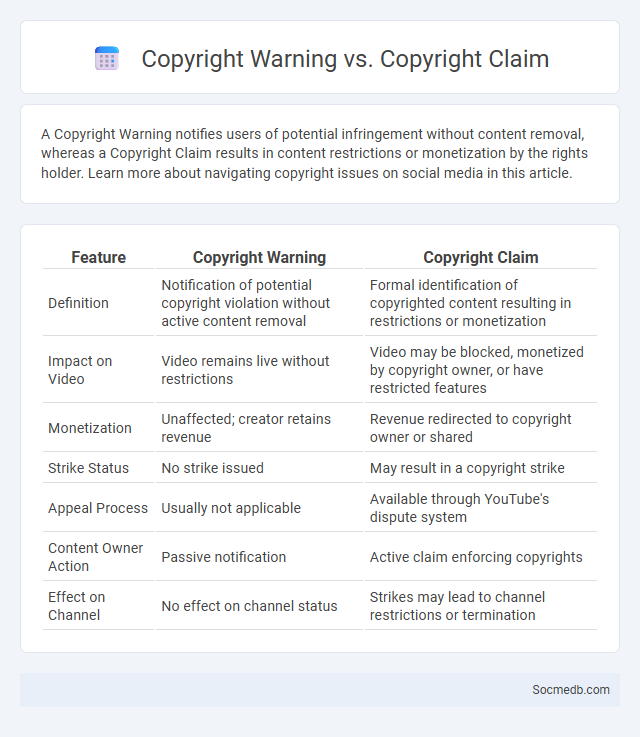
Photo illustration: Copyright Warning vs Copyright Claim
A Copyright Warning notifies users of potential infringement without content removal, whereas a Copyright Claim results in content restrictions or monetization by the rights holder. Learn more about navigating copyright issues on social media in this article.
Table of Comparison
| Feature | Copyright Warning | Copyright Claim |
|---|---|---|
| Definition | Notification of potential copyright violation without active content removal | Formal identification of copyrighted content resulting in restrictions or monetization |
| Impact on Video | Video remains live without restrictions | Video may be blocked, monetized by copyright owner, or have restricted features |
| Monetization | Unaffected; creator retains revenue | Revenue redirected to copyright owner or shared |
| Strike Status | No strike issued | May result in a copyright strike |
| Appeal Process | Usually not applicable | Available through YouTube's dispute system |
| Content Owner Action | Passive notification | Active claim enforcing copyrights |
| Effect on Channel | No effect on channel status | Strikes may lead to channel restrictions or termination |
Understanding Copyright: Basic Definitions
Copyright protects original works such as images, videos, and text shared on social media platforms, granting creators exclusive rights to use and distribute their content. Understanding key terms like "fair use," "public domain," and "derivative works" helps users navigate legal boundaries and avoid infringement. Awareness of copyright policies on platforms like Instagram, Facebook, and YouTube is essential for responsible content creation and sharing.
What Is a Copyright Warning?
A copyright warning notifies you that content you shared or accessed may infringe on someone else's intellectual property rights, emphasizing the importance of respecting original creators. Social media platforms use these warnings to prevent unauthorized distribution of copyrighted material and protect both users and rights holders. Understanding and responding promptly to a copyright warning can help you avoid account penalties or content removal.
How Copyright Warnings Work
Copyright warnings on social media platforms function by detecting unauthorized use of protected content through automated systems like content ID or fingerprinting technology. When Your content is flagged, the warning notifies you or other users of potential copyright infringement, often restricting access, removing the content, or imposing penalties such as account suspension. These warnings serve to protect intellectual property rights and encourage compliance with copyright laws by empowering creators and rights holders to manage their content online.
Explaining Copyright Claims: Purpose and Process
Copyright claims on social media serve to protect creators' intellectual property by preventing unauthorized use of their original content such as images, videos, and music. When a claim is filed, the platform reviews the content to verify ownership and may remove or mute the disputed material to comply with copyright laws like the DMCA. Users can dispute claims if they believe their use is fair or authorized, initiating a formal process that can result in the restoration or permanent removal of the content based on legal standards.
Copyright Claim vs Copyright Warning: Key Differences
A copyright claim indicates that the content you posted has been identified as infringing on someone else's rights, potentially leading to removal, monetization by the copyright owner, or legal consequences. A copyright warning serves as an alert to inform you of possible infringement without severe penalties, often allowing you to review or dispute the claim. Understanding the distinction between copyright claim and copyright warning is crucial for protecting your content and maintaining compliance on social media platforms.
What Is a Copyright Strike?
A copyright strike occurs when a social media platform removes your content due to a copyright infringement claim, signaling a serious violation of intellectual property laws. Receiving a copyright strike can limit your account's features, restrict your ability to upload new content, or even lead to account suspension if repeated offenses happen. Understanding how to avoid copyright strikes protects your social media presence and ensures your creative work remains accessible to your audience.
Consequences of Copyright Strikes
Copyright strikes on social media can lead to severe consequences including account suspension, reduced visibility, and loss of monetization privileges. You may experience permanent bans if multiple strikes accumulate, significantly impacting your content's reach and opportunities for engagement. Understanding platform-specific copyright policies is essential to protect your digital presence and maintain a sustainable online brand.
How to Respond to Copyright Warnings, Claims, and Strikes
When responding to copyright warnings, claims, and strikes on social media platforms like YouTube, Facebook, or Instagram, immediately review the disputed content to verify whether it violates copyright laws. If you believe your content is protected under fair use or you have permission, promptly submit a counter-notification or dispute through the platform's official process to avoid account penalties. Keep records of all communications and consider consulting legal expertise to address recurring claims and protect your digital rights effectively.
Best Practices to Avoid Copyright Issues
To avoid copyright issues on social media, always verify the ownership and licensing of content before sharing or reposting. Use royalty-free or licensed images, music, and videos, and provide proper attribution when required by copyright holders. Regularly review platform-specific copyright policies and employ tools like content ID systems to monitor and manage potential infringements effectively.
Frequently Asked Questions about Copyright Enforcement
Social media platforms often receive inquiries about copyright enforcement, including how copyrighted content is identified and removed, the process for filing a copyright infringement complaint, and the consequences for violating copyright laws. You should understand the Digital Millennium Copyright Act (DMCA) takedown notices and how platforms use automated tools and human review to enforce rules. Knowing your rights and responsibilities ensures that your content is protected and that you avoid unintentional infringements.
 socmedb.com
socmedb.com